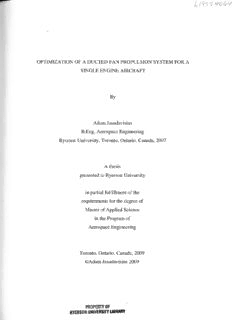Table Of ContentOPTIMIZATION OF A DUCTED FAN PROPULSION SYSTEM FOR A
SINGLE ENGINE AIRCRAFT
By
Adam J asudavisius
B.Eng, Aerospace Engineering
Ryerson University, Toronto, Ontario, Canada, 2007
A thesis
presented to Ryerson University
in partial fulfillment of the
requirements for the degree of
Master of Applied Science
in the Program of
Aerospace Engineering
Toronto, Ontario, Canada, 2009
©Adam Jasudavisius 2009
PROPERTY OF
RYERSON UNIVERSITY U8RARY
Author's Declaration
I hereby declare that I, Adam J asudavisius, am the sole author of this thesis titled "Optimization
of a Ducted Fan Propulsion System for a Single Engine Aircraft".
I authorize Ryerson University to lend this thesis or dissertation to other institutions or
individuals for the purpose of scholarly research.
Adam Jasudavisius
I further authorize Ryerson University to reproduce this thesis or dissertation by photocopying or
by other means, in total or in part, at the request of other institutions or individuals for the
purpose of scholarly research.
111
This page intentionally left blank
Abstract
OPTIMIZATION OF A DUCTED FAN PROPULSION SYSTEM FOR A
SINGLE ENGINE AIRCRAFT
Master of Applied Science
2009
Adam Jasudavisius
Aerospace Engineering
Ryerson University
The objective of this study was to perform a 3D aerodynamic shape optimization on a ducted fan
propulsion system configured for cruise flight on an aircraft. The initial shapes of the duct and
hub were determined using a basic grid searching optimization approach. An efficient
optimization algorithm was created that utilized the BFGS searching technique with a Quasi
Newton line search to refine the initial geometry. The ducted fan was chosen to be controlled by
13 control points connected using a combination of splines, ellipses and conics. The optimum
design resulted in a 33.54% and 36.45% reduction in drag for the duct and hub respectively. The
propeller thrust was also increased by 141.49%. The optimization methodology used throughout
this study proved to be an efficient technique in finding the optimal design to within a high
degree of resolution based on the entire design space considered.
v
This page intentionally left blank
Acknowledgments
The author would like to thank Dr. Paul Walsh for all of his help and guidance throughout this
project, as well as Mecachrome for their constant support, and of eourse to Hines Aircraft for
providing this great opportunity. Acknowledgments are also given to the author's fellow
colleagues who were always there for advice and to the author's girlfriend, Stephanie, for her
exceptional support and patience.
Vll
This page intentionally left blank
Vlll
Table of Contents
Author's Declaration ...................................................................................................................... iii
Abstract ........................................................................................................................................... v
Acknowledgments ......................................................................................................................... vii
List of Tables ............................................................................................................................... xiii
List of Figures ............................................................................................................................... xv
List of Appendices ...................................................................................................................... xvii
Nomenclature ............................................................................................................................... xix
1 Introduction ............................................................................................................................ 1
1.1 Background Information ................................................................................................ 1
1.2 Literature Review ........................................................................................................... 2
1.3 Objective ......................................................................................................................... 4
1.4 Thesis Summary ............................................................................................................. 4
2 Two-Dimensional Optimization ............................................................................................ 7
2.1 Introduction .................................................................................................................... 7
2.2 Propeller Design ............................................................................................................. 8
lX
2.2.1 Background Theory .......................................................................................... 8
2.2.2 Algorithm Iteration Process ............................................................................ 12
2.2.3 Propeller Design Steps ................................................................................... 13
2.3 CFD Analysis ............................................................................................................... 17
2.3.1 Exporting the Propeller Data .......................................................................... 17
2.3 .2 Test Areas and Configurations ....................................................................... 19
2.3.3 Mesh Validation ............................................................................................. 20
2.4 Two-Dimensional Results ............................................................................................ 25
2.4.1 Inviscid Results .............................................................................................. 25
2.4.2 Viscous Results .............................................................................................. 29
3 Numerical Optimization Algorithm ................................................................................... 31
3.1 Introduction .................................................................................................................. 31
3.2 Objective Function ....................................................................................................... 32
3.3 One-Dimensional Minimizations Methods .................................................................. 33
3.4 Multi-Dimensional Minimization Methods .................................................................. 36
3.5 Constrained Optimization ............................................................................................. 40
4 Three-Dimensional Optimization ....................................................................................... 45
4.1 Introduction .................................................................................................................. 45
4.2 Geometry Specifications .............................................................................................. 47
4.2.1 Initial Duct Geometry ..................................................................................... 47
4.2.2 Initial Hub Geometry ...................................................................................... 49
4.2.3 Propeller Geometry ........................................................................................ 51
4.3 Operational Constraints ................................................................................................ 52
4.4 Mesh Characteristics .................................................................................................... 54
4.4.1 Mesh Spacing ................................................................................................. 54
X
4.4.2 Error Approximation ...................................................................................... 55
~-
4.5 Perturbation Size Study ................................................................................................ 60
4.6 Two-dimensional Validation of Optimization Algorithm ............................................ 66
4.7 Three-Dimensional Results ................................................. :. ....................................... 70
4.7.1 Case 1 ............................................................................................................. 70
4.7.2 Case 2 ............................................................................................................. 74
5 Conclusions and Future Work ............................................................................................ 77
5.1 Two-Dimensional Findings .......................................................................................... 77
5.2 Three-Dimensional Findings ........................................................................................ 78
5.3 Future Work .................................................................................................................. 78
Appendix I - Propeller Program Output .................................................................................. 79
Appendix II - 2D Validation Convergence History ................................................................. 80
Appendix III - Resultant Views for Final Cases ...................................................................... 81
References .................................................................................................................................... 85
Xl
Description:The ducted fan was chosen to be controlled by. 13 control points connected using a combination of splines, ellipses and conics. The optimum design resulted in a .. Page 10 .. Figure 4.3: Initial duct cross-section for Case 1 (from 2D optimization) . In Chapter 3, the optimization algorithm used in.

